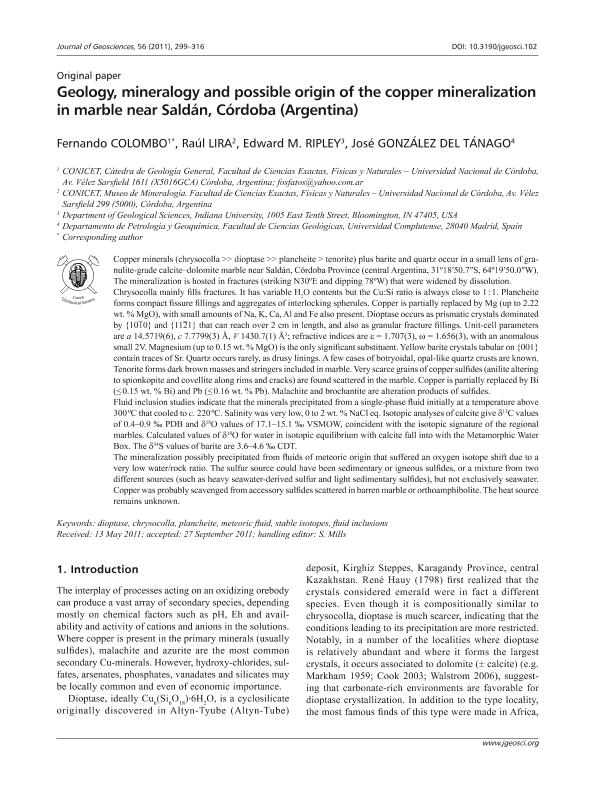Artículo
Geology, mineralogy and possible origin of the copper mineralization in marble near Saldán, Córdoba (Argentina)
Fecha de publicación:
11/2011
Editorial:
Czech Geological Society
Revista:
Journal of Geosciences
ISSN:
1802-6222
e-ISSN:
1803-1943
Idioma:
Inglés
Tipo de recurso:
Artículo publicado
Clasificación temática:
Resumen
Copper minerals (chrysocolla ≫ dioptase ≫ plancheite > tenorite) plus barite and quartz occur in a small lens of granulite- grade calcite-dolomite marble near Saldán, Córdoba Province (central Argentina, 31°18′50.7″S, 64°19′50.0″W). The mineralization is hosted in fractures (striking N30°E and dipping 78°W) that were widened by dissolution. Chrysocolla mainly fills fractures. It has variable H2O contents but the Cu:Si ratio is always close to 1: 1. Plancheite forms compact fissure fillings and aggregates of interlocking spherules. Copper is partially replaced by Mg (up to 2.22 wt. % MgO), with small amounts of Na, K, Ca, Al and Fe also present. Dioptase occurs as prismatic crystals dominated by {10 10} and {11 21} that can reach over 2 cm in length, and also as granular fracture fillings. Unit-cell parameters are a 14.5719(6), c 7.7799(3) Å, V 1430.7(1) Å3; refractive indices are ε = 1.707(3), ω = 1.656(3), with an anomalous small 2V. Magnesium (up to 0.15 wt. % MgO) is the only significant substituent. Yellow barite crystals tabular on {001} contain traces of Sr. Quartz occurs rarely, as drusy linings. A few cases of botryoidal, opal-like quartz crusts are known. Tenorite forms dark brown masses and stringers included in marble. Very scarce grains of copper sulfides (anilite altering to spionkopite and covellite along rims and cracks) are found scattered in the marble. Copper is partially replaced by Bi (≤ 0.15 wt. % Bi) and Pb (≤ 0.16 wt. % Pb). Malachite and brochantite are alteration products of sulfides. Fluid inclusion studies indicate that the minerals precipitated from a single-phase fluid initially at a temperature above 300°C that cooled to c. 220°C. Salinity was very low, 0 to 2 wt. % NaCl eq. Isotopic analyses of calcite give δ13C values of 0.4-0.9 ‰ PDB and δ18O values of 17.1-15.1 ‰ VSMOW, coincident with the isotopic signature of the regional marbles. Calculated values of δ18O for water in isotopic equilibrium with calcite fall into with the Metamorphic Water Box. The δ34S values of barite are 3.6-4.6 ‰ CDT. The mineralization possibly precipitated from fluids of meteoric origin that suffered an oxygen isotope shift due to a very low water/rock ratio. The sulfur source could have been sedimentary or igneous sulfides, or a mixture from two different sources (such as heavy seawater-derived sulfur and light sedimentary sulfides), but not exclusively seawater. Copper was probably scavenged from accessory sulfides scattered in barren marble or orthoamphibolite. The heat source remains unknown.
Palabras clave:
Chrysocolla
,
Dioptase
,
Fluid Inclusions
,
Meteoric Fluid
,
Plancheite
,
Stable Isotopes
Archivos asociados
Licencia
Identificadores
Colecciones
Articulos(CICTERRA)
Articulos de CENTRO DE INVEST.EN CS.DE LA TIERRA
Articulos de CENTRO DE INVEST.EN CS.DE LA TIERRA
Citación
Colombo, Fernando; Lira, Raul; Ripley, Edward; González del Tánago, José; Geology, mineralogy and possible origin of the copper mineralization in marble near Saldán, Córdoba (Argentina); Czech Geological Society; Journal of Geosciences; 56; 3; 11-2011; 299-316
Compartir
Altmétricas




